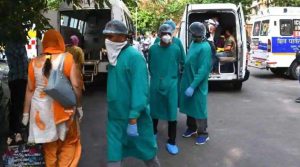JULY 26, 2020

Karnataka, Andhra Pradesh, West Bengal and Bihar face the immediate risk of becoming the new hotspots of the coronavirus disease (Covid-19) in India, due to a rapid increase in new cases, rising positivity rates and (for the last two) low testing, according to data analysed by HT.
To identify the new hotspots of the outbreak, HT analysed data from India’s 20 most populous regions, looking for three factors — a rising positivity rate, a high growth rate of daily cases, and low tests performed per million residents — that have marked all hotspots globally. These factors were also common to Maharashtra, Tamil Nadu and Delhi, which became the clear hotspots in the first four months of the spread of the virus in the country.
Delhi is the only state in the country that has reported a clear turnaround with performance improving on the three parameters. Maharashtra and Tamil Nadu have both intensified their testing, but still have high positivity rates, and continue to report high case numbers.
Over the past month, several states appeared to stand out with poor numbers on at least one of the three factors — Andhra Pradesh, Karnataka, West Bengal, Bihar, Kerala, Jharkhand, Uttar Pradesh, Madhya Pradesh, Rajasthan and Odisha.
Among them, four — Karnataka, Andhra Pradesh, West Bengal and Bihar — have exhibited the most alarming numbers, and confront the immediate risk of the outbreak severely intensifying.
To be sure, Telangana, Uttar Pradesh and Gujarat, have improved their doubling rate in the above mentioned time period, but remain low on testing, which may have suppressed other Covid-19 statistics.
RATE OF INCREASE IN CASES
The rate of increase in daily cases can be denoted in what is known as doubling rate —the number of days it takes for a given number of infections to double (the higher the number, the better).
Andhra Pradesh has the worst doubling rate of all states in the country, followed by Kerala and Karnataka (see chart). What is alarming is that a month ago, these states already had doubling rates much worse than the national average (19.3 days), and have dropped further down. In a month, Andhra Pradesh’s doubling rate dropped from 13.2 days to 7 days. For Kerala, the doubling rate fell from 28 days to 11 days and it dropped from 17 days to 11.5 days in Karnataka.
The next two states on the list – Jharkhand and Bihar – have both reported massive drops in their doubling rate. Jharkhand’s doubling rate fell from 30.9 days to 12.9 in a month, and Bihar’s, 27.9 days to 12.9.
In the last 30 days, only five states — Delhi, Telangana, Haryana, Tamil Nadu and Uttar Pradesh — have improved their doubling rate. Delhi has been, by far, the standout in this regard, with the doubling rate improving from 13 days to 76.6 days in a month.
RISING POSITIVITY RATE
In 15 of the 20 states, the Covid-19 positivity rate – the proportion of people testing positive to those tested – was found rising in the last month. Maharashtra, the state that has been the worst-hit by the virus, still has the highest average positivity rate at 21% (up 0.3 percentage points in the last month).
West Bengal has reported the third highest positivity rate in the country, 16.1% (up 11.9% from last month). Karnataka’s (second highest overall positivity rate) increased 13.5 percentage points in the last month (from 3.2% to 16.7%) while Andhra Pradesh’s positivity rate jumped 10.8 points (2.2% to 13%). The overall national average for positivity rate is 8.5%.
And among the five that dropped their positivity rate, only Delhi and Telangana saw a sizeable change. Tamil Nadu’s positivity rate only changed 0.2 percentage points and continues to remain close to 10%.
Telangana, which had the highest positivity rate 30 days ago, has managed to improve its performance significantly – the number fell from 21.9% to 9.9%. The cause of this improvement can be explained by one factor – a rise in testing. In the last week, the state has tested over 14,000 samples a day on an average; this was 3,800 a month ago. However, as mentioned above, the state remains one of the laggards in the country when it comes to testing, with only 9,075 tests per million residents.
RATE OF TESTING
This is a parameter that offers hope for residents of Andhra Pradesh (30,556 tests per million residents) and Karnataka (17,375 tests per million) — both perform much better than the national average of 12,222 tests per million.
Bihar remains worst-performing testing state in the country on this front, testing just about a quarter of the national average (3,699 tests per million). It is joined by Jharkhand (6775), Uttar Pradesh (7834), West Bengal (8143) and Madhya Pradesh (8323) in the bottom five.
Though Gujarat has performed well on doubling rate and positivity rate, testing in the state (9136 tests per million) remains much lower than the national average.
Follow the government’s latest guidance on safeguarding yourself during the coronavirus pandemic, including travel advice within and outside the country. The World Health Organization has also busted some myths surrounding coronavirus. The Ministry of Health’s special helpline is available at +91-11-23978046, ncov2019@gmail.com and ncov2019@gov.in.
Courtesy/Source: Hindustan Times










































































































